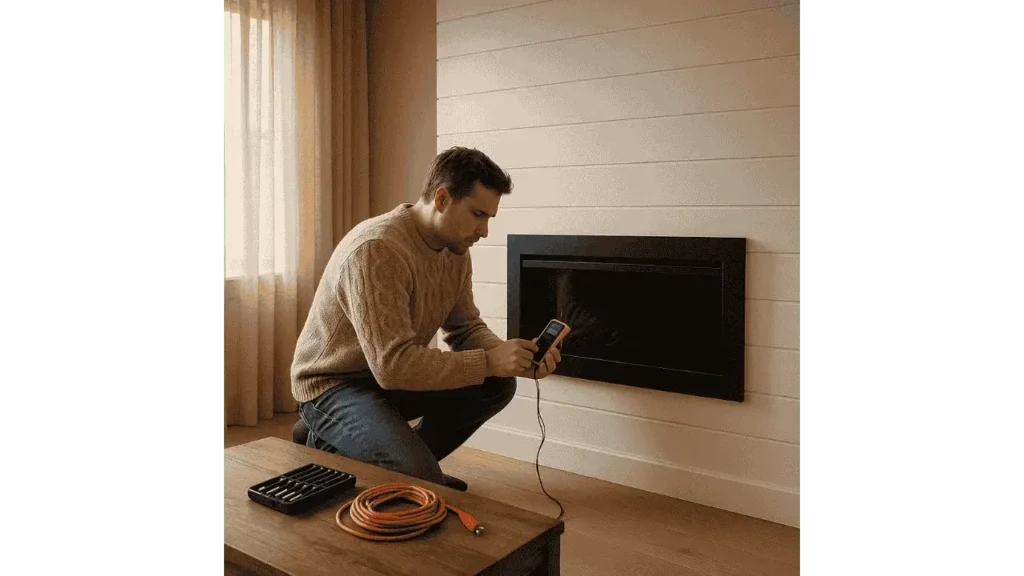Electric fireplaces are designed to offer comfort with minimal effort, but even the most reliable models can suddenly stop working. Whether it’s refusing to power on, not producing heat, or making strange noises, issues can arise that leave you wondering what’s gone wrong. As someone who’s relied on an electric fireplace through chilly winters, I know how frustrating it can be when it acts up without warning. Fortunately, many of these problems have simple causes and even simpler solutions, if you know where to look.
1. Fireplace Won’t Turn On
Check Power Supply & Outlet
When your electric fireplace doesn’t turn on at all, start with the basics. Make sure the plug hasn’t come loose or wiggled out from the wall; this happens more often than you’d expect. I once discovered my toddler had unplugged ours to charge a toy car. Test the outlet with another device like a lamp or phone charger. If the outlet is dead, you might be dealing with a tripped breaker or a larger electrical issue.
Check Breakers or Fuses
A tripped circuit breaker or a blown internal fuse can prevent the unit from receiving power. Head to your breaker box and see if any switches have flipped. Some fireplaces have a fuse inside the body panel that may need replacing. If you’re not sure how to access it, refer to the manufacturer’s manual or contact support for help. According to Alan McCarthy, a certified appliance technician with 15 years in the field,
“Over half of the non-start issues I see are due to simple breaker trips or overlooked fuses.”
Reset the Unit
Electric fireplaces are built with safety features that can shut them down automatically. If the fireplace overheats, it may activate thermal protection mode. Unplugging it for 5 to 15 minutes allows the unit to reset. I’ve had success reviving a non-responsive unit just by letting it cool off and plugging it back in.
Learn More: 23 White Fireplace Ideas to Brighten Your Home
2. Heat Isn’t Working Even When the Unit Powers On
Thermostat Setting Too Low
If your fireplace powers on but produces no heat, check the thermostat setting first. The unit won’t activate the heater unless the temperature is set above the room’s current level. I’ve mistakenly left mine set to 65°F when the room was already 68°F, leading me to believe something was broken.
Blocked Vents or Airflow
Proper ventilation is key to heating. Obstructed vents can prevent warm air from circulating. Dust buildup, furniture placement, or even pet hair can reduce airflow. Make it a habit to vacuum or wipe down the intake and exhaust vents every few weeks, especially during heavy use months.
Faulty Heating Element or Fan
If the flame is visible but no heat is coming out, you could be dealing with a failed heating element or a malfunctioning blower fan. According to technician Leo Simonds, who specializes in fireplace repairs in Ontario,
“The blower motor is often the culprit when the flame runs, but no heat is felt. Replacing it usually resolves the issue.”
A qualified service technician can test the components safely and recommend a fix.
3. Flame Effect Not Working or Flickering
Flame Setting Disabled
Some fireplaces allow independent control of the flame and heat. Make sure the flame setting hasn’t been disabled on the control panel or remote. It’s surprisingly easy to hit the wrong button and assume something’s faulty when it’s just a setting.
Bulbs or Motor Fault
The flame effect is often generated by lightbulbs reflecting against a rotating motorized element. If the flame is dim, flickering, or not appearing at all, the bulbs might be burned out. On older models, these are simple to replace with standard halogen or LED bulbs. If the motion isn’t smooth or the flame appears jumpy, the motor may need attention. This was the issue with mine last fall, and swapping in a replacement motor solved it completely.
4. Strange Noises or Smells
Grinding, Buzzing, or Rattling Sounds
Electric fireplaces should run quietly. If you start hearing odd sounds, it’s likely a loose internal part or an issue with the fan or motor. Sometimes it’s a matter of tightening screws or repositioning panels. I once discovered a small screw had come loose and dropped inside the fan housing, causing a terrible rattle until removed.
Persistent Burning or Plastic Smell
It’s normal for new units to emit a faint smell during the first few uses as manufacturing residue burns off. But if a chemical or plastic-like odor continues, unplug the unit immediately. This could point to melted wiring or an overheating component. As safety consultant Rachel Givens warns, “Any lingering odor after the first few uses should be taken seriously, that’s not something to ignore.”
Final Takeaways
Start with simple checks; make sure the fireplace is plugged in and reset it. That alone resolves many power issues.
If the unit powers on but doesn’t heat or display flames, look into thermostat settings, vent blockages, or a faulty heating mechanism.
Ongoing smells or unusual noises usually mean it’s time to involve a professional. Don’t attempt internal repairs if you’re unsure.
Keeping your fireplace clean and inspecting it regularly is the easiest way to avoid future problems. Preventive care goes a long way with electric units, and a few minutes of attention can save you a lot of hassle down the line.
- 27 Farmhouse Fireplace Ideas That Bring Warmth & Charm - August 18, 2025
- 25 Fireplace Lighting Ideas to Illuminate Your Hearth - August 7, 2025
- How to Replace an Electric Fireplace Switch? - August 5, 2025



